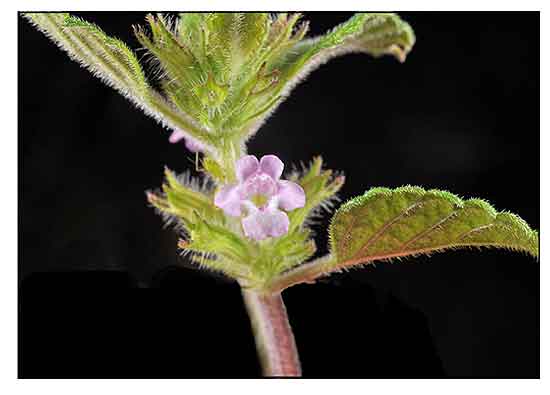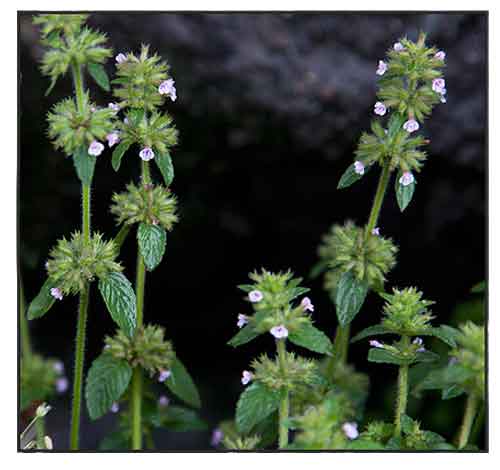 Gen info Gen info
- Clinopodium is a genus of flowering plants in the family Lamiaceae, in the subtribe Menthinae.
- Etymology: The genus name Clinopodium derives from Latin clinopodion, from the Ancient Greek klinopodion, from kline "bed" and podion "little foot". The names were for Clinopodium vulgare, alluding to the form of the calyx. (3)
- Clinopodium has been defined differently by various authors, some restricting it to as few as 13 species, closely related to the type species, Clinopodium vulgare. In the latest revision of Lamiaceae , Clinopodium encompassed abut 100 species. Currently, Clinopodium includes both a core clade of the genus that includes the type species and a sister clade, a broad assemblage of New World species alongside species included in 22 other genera. The Clinopodium complex awaits a systematic taxonomic and nomenclatura review before valid names can be designated. (3)
 Botany Botany
• Perennial herb with a slender rootstock. Stems few or several, branched or not, 20-40 cm, erect or ascending, usually slender, pilose with eglandular white spreading or retrorse hairs. Leaves thin-textured, 10-30 x 5-20 mm, broadly ovate to ovate-oblong, subentire, crenulate to serrate, rounded at base, acute above, sparingly pilose especially on veins beneath, with or without scattered sessile oil globules; petiole to c. 10 mm, often much less. Verticillasters in axils of upper leaves, 10-20 (-40)-flowered, loose or more or less so, remote, terminal and axillary. Bracts 1.5-4 mm. Pedicels erect-spreading, 2-3 mm. Calyx 5-6 mm, curved, with long spreading eglandular hairs and with or without scattered capitate glandular hairs; teeth of upper lip 0.5-1 mm, triangular; teeth of lower lip c. 1.5 mm subulate, ciliate. Corolla pink to purple, 6-9 mm; tube included within or scarcely exserted from calyx teeth. Thecae glabrous, parallel or divergent. Nutlets c. 0.8 x 0.5 mm, smooth, subglobose, with a white attachment scar. (Flora of Pakistan)
Distribution
- Native to the
Philippines. (2)
- In Luzon: Abra, Benguet, Ifugao, Mountain Province, Nueva Viscaya. (2)
- Native to
Afghanistan, Assam, East Himalaya, Iran, Myanmar, Nepal, North Caucasus, Pakistan, Tibet, Transcaucasus, Türkey, West Himalaya. (1)
 Constituents Constituents
- A methanol extract of aerial parts yielded rosmarinic acid, buddlejasaponin IVa and buddle-jasaponin IV as main constituents.
(5)
-
Phytochemical analysis showed presence of rosmarinic acid, buddlejasaponin GC-MS study of aerial parts for essential oil yielded 17 compounds corresponding to 74.68% of total oil, with components classified as non-terpenes (69.06%), oxygenated diterpenes (3.67%), and hydrocarbon monoterpenes (1.95%). Among non-terpenes, tolualdehyde (29.16%), palmitic acid (17.57%), and acetophenone (13.44%) were the main constituents. (5)
- Methanolic extract yielded total flavonoid and total phenolic contents of 4.25 mg QE and 5.14 mg GAE in 100 g dry plant.
(5)
- Study of whole herb isolated and identified 15 crystalline components, including five steroids (α-spinasterone, β-sitosterol, stigmasterol, α-spinasterol, and α-spinasteryl-3-O-β-glucopyranoside), four triterpenoids (3β-hydroxyurs-11-en-28,13-olide, betulinic acid, oleanolic acid, ursolic acid), four flavonoids (luteolin, luteolin-7-O-β-glucopyranoside, apigenin-7-O-β-glucuronide, and apigenin-7-O-β-methylglucuronate), and two lignolic acids [3-(3,4-dihydroxyphenyl)- lactic acid and rosmarinic acid]. (6)
Properties
- Studies have suggested antioxidant, anticancer, antiviral properties.
Parts used
Aerial parts, leaves.
 Uses Uses
Edibility
- No information found on edibility.
Folkloric
- Healers in Ramon Magsaysay, Zamboanga del Sur, use decoction of leaves for stomach ache. (4)
- In Nepal, juice of leaves applied to cuts and wounds.
- In traditional medicine of Iran and other countries, used for treatment of hypertension, pain, inflammation, wound healing, scratches and cuts. Natives use the plant as astringent, anti-bloating, and blood purifier; leaves used for gastric problems. (5)
- In India, plant used as astringent, carminative, and blood purifier;
leaves used for gastric troubles. (8) Leaf infusion used for fever. (9) Tribal migratory shepherds in Mandi Himachal Pradesh use the herb as astringent, carminative, and heart tonic. (10) Infusion of aerial parts used to provide birthing relief in women. (12)
- In Nepalese traditional medicine, aerial parts used for
high blood pressure, pain, and body inflammation. (13)
Others
- Forage: Flowers used as source of bee forage.
Studies
• Antioxidant / Aerial Parts / Essential Oil: Methanolic extract yielded total flavonoid and total phenolic contents of 4.25 mg QE and 5.14 mg GAE in 100 g dry plant. DPPH free radical scavenging potential of the MeOH extract inhibiting 50% of DPPH radicals was calculated as 38.52%, and 6.73 µg/mL for quercetin. Low concentrations of MeOH showed high radical scavenging activity, and as concentration increased, trapping of DPPH free radicals also increased. The antioxidant activity correlated with high percentage of phenolic and flavonoid contents. (see constituents above) (3)
• Buddlejasaponins / Anticancer / Aerial Parts: Study evaluated extracts and fractions of aerial parts for cytotoxicity against oral cancer cells (HN-5) and human umbilical vein endothelial cells (HUVECs) by MTT assay. C. umbrosum showed significant cytotoxicity on HN-5 cells. The mechanism of cytotoxicity of the two major compounds buddlejasaponin IV ands IVa was identified as the mitochondrial pathway of apoptosis reducing the invasive potential of HN-5 cells. The compounds reduced metastasis of oral cancer cell line. Highest cytotoxicity was observed with buddlejasaponin IV. (7)
• Antioxidant / Rosmarinic Acid / Aerial Parts: Study evaluated various extracts of aerial parts for phytochemical contents and antioxidant property. Structure elucidation of purified compound revealed the presence of a caffeic acid derivative in the methanol extract. GC-MS analysis of EO showed limonene, acetophenone, palmitic acid, and phytol as most frequent components. Rosmarinic acid was the main component of the methanol extract with prominent antioxidant activity. (11)
• Antiviral / HSV-1: In a study of Nepalese plants for antiviral activity against HSV-1/Vero cells, methanol extract of Clinopodium umbrosum cytotoxicity with CC50 of 76 µg/ml and moderate antiviral activity with IC50 of 19 µg/ml. Against Influenza A, CC50 was >100 µg/ml. (13)
Availability
- Wild-crafted.
- Plants in the cybermarket.
|

![]()





 Constituents
Constituents
